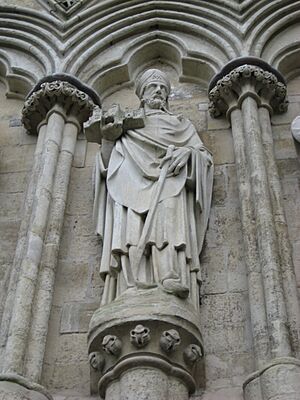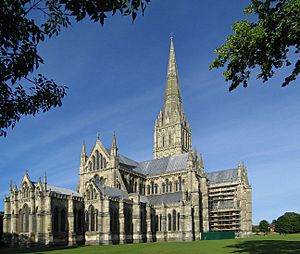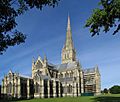Richard Poore facts for kids
Quick facts for kids Richard Poore |
|
|---|---|
| Bishop of Durham | |

Sculpture on the west front of Salisbury Cathedral of Richard Poore, holding a model of the cathedral in his hand
|
|
| Appointed | 14 May 1228 |
| Reign ended | 15 April 1237 |
| Predecessor | William Scot |
| Successor | Thomas de Melsonby |
| Other posts | Bishop of Chichester Bishop of Salisbury Dean of Salisbury |
| Orders | |
| Consecration | 25 January 1215 |
| Personal details | |
| Died | 15 April 1237 Tarrant Keyneston, Dorset |
| Buried | probably church at Tarrant Keyneston, Dorset |
| Denomination | Catholic |
Richard Poore (died 15 April 1237) was an important English bishop during the Middle Ages. He is most famous for helping to build the beautiful Salisbury Cathedral and for planning the city of Salisbury. This new city was built away from the older, crowded fortress of Old Sarum. Richard Poore served as a bishop in three different places: Chichester, Salisbury, and Durham.
Contents
Richard Poore's Early Life
Richard Poore was likely the son of Richard of Ilchester, who was also known as Richard Toclive. His father was the Bishop of Winchester. Richard also had a brother named Herbert Poore, who was the Bishop of Salisbury before him.
Richard studied in Paris with a famous teacher named Stephen Langton. In 1197, Richard Poore became the Dean of Salisbury. A dean is a high-ranking church official.
Challenges and Teaching
In 1213, Richard was chosen to be the Bishop of Durham. However, Pope Innocent III did not allow this choice. This was probably because King John wanted his own advisor, John de Gray, to become the Bishop of Durham instead.
During King John's rule, the Pope placed an "interdict" on England. This meant that many church services and ceremonies were stopped. During this time, Richard went back to Paris to teach. He stayed there until the interdict was lifted.
Important Writings
Before he became a bishop, Richard Poore wrote several important books. These books helped guide how the church worked in Salisbury.
- The Institutio explained the duties and rights of the church leaders at Salisbury Cathedral.
- The Ordinale described the church services and how different special services fit into the regular worship.
- The Consuetudinarium explained the customs and traditions of Salisbury itself.
Both the Consuetudinarium and the Ordinale were guides for the Sarum Rite. This was the common way church services were done in England during the 1200s.
Becoming Bishop of Chichester
In 1215, Richard Poore became the Bishop of Chichester. He was chosen around January 7 and officially became bishop on January 25 in Reading. He also attended a very important church meeting called the Fourth Lateran Council in 1215. Richard was also one of the people in charge of King John's money and property after the king died.
Bishop of Salisbury and Cathedral Building

Richard's brother, Herbert Poore, died in 1217. Richard then took over his brother's position as Bishop of Salisbury by June 27. He became bishop of Salisbury thanks to a special representative of the Pope, Cardinal Guala Bicchieri.
Building a New Cathedral and City
While he was Bishop of Salisbury, Richard Poore led the huge project of building the new Salisbury Cathedral. This new cathedral was meant to replace the old one at Old Sarum. The old church was in a cramped, military town.
In 1219, Richard also planned out the new town of Salisbury. This new town gave the workers building the cathedral more space. The cathedral itself was not finished and officially opened until 1258.
Church Rules and New Friars
While in Salisbury, Richard Poore created his Statutes of Durham. These were a set of rules for how the church should be run. They were very important and influenced many other church laws.
Around 1225, Richard also welcomed the first Franciscan friars to Salisbury. Friars are like monks, but they live among people and help them.
Working with Leaders
Richard Poore also served as a royal judge in 1218 and 1219. In 1223, he helped Hubert de Burgh take control of the government. He worked with Stephen Langton and Jocelin of Wells (the Bishop of Bath and Wells) to govern England for the next five years.
Richard Poore also took part in moving the remains of two saints: St Wulfstan in 1218 and Saint Thomas Becket in 1220. At the event for Thomas Becket, Richard was the only bishop besides Stephen Langton to actually look at Becket's body. Richard also asked Pope Gregory IX to make the second Bishop of Salisbury, Osmund de Sees, a saint. However, Osmund was not made a saint until 1457.
Bishop of Durham
On May 14, 1228, Richard Poore was moved to become the Bishop of Durham. After this, he mostly stopped working for the king. He only briefly returned to royal service in 1232 and 1233.
Solving Church Problems
In Durham, Richard faced a disagreement between the bishop and the cathedral chapter. The cathedral chapter was a group of clergy who helped run the cathedral. The disagreement was about who could choose the prior (the head of the monastery) and whether the bishop could visit the monastery to check on things.
Soon after arriving in Durham, Richard created a detailed set of rules. These rules helped manage the relationship between the bishop, the prior, and the cathedral chapter. These rules were the basis for how the church was run in Durham until the time of Henry VIII.
Richard Poore's Legacy and Death
Richard Poore cared deeply about education and helping people.
Education and Care for Clergy
In 1220, when he was Bishop of Salisbury, Richard told his clergy to teach a few children. These children would then teach other children basic church lessons and prayers. He also made sure the clergy preached every Sunday that children should not be left alone near fires or water.
During his time in Salisbury, he also supported boys' education. He gave money and positions to schoolmasters so they would not charge for teaching. In 1237, he set up a retirement home for old and sick clergy in the Durham area.
Against Holding Multiple Jobs
Richard Poore was against "pluralism." This was when a church leader held more than one church position at the same time. He believed that if a clerk got a new position, they should give up their old one. If they argued about it, he said they should lose both jobs! He also said that clergy should not be involved in "worldly business."
Today, Poore House at Bishop Wordsworth's School in Salisbury is named after him. This honors his work for schools in Salisbury.
Death and Burial
Richard Poore died on April 15, 1237, at a place called Tarrant Keyneston in Dorset. Both Durham and Salisbury claimed his tomb. However, he was most likely buried in the church at Tarrant Keyneston, which is what he had wanted. A statue of him stands in niche 170 on the west front of Salisbury Cathedral. He is shown holding a model of the cathedral.
Images for kids



